
Exterior lamp appearance

Headlight Switch
The QX30 is equipped with a headlight switch that features a variety of different exterior lighting controls that can be selected for headlamp, parking lamp and fog lamp operation. The rotary style light switch does not include an OFF position.

1. Left-side parking lights
2. Right-side parking lights
3. Sidelights (both sides), taillights, license plate lights, front parking lights, and combination meter. This position is similar to the parking light position on other Infiniti models.
4. Automatic headlamp mode
5. Manual headlamps
6. Rear fog light
7. Front fog lights (if so equipped)
8. Manual headlight aiming control (halogen headlights equipped vehicles only)

Explanation of not having an OFF position
The QX30 is equipped with an Auto Light system that is managed by the BCM with input from a wiper-linked auto lighting function and the rotary light switch.
When the rotary light switch is in the AUTO position, the headlamp ON/OFF function is determined by the light & rain sensor, which is located on the windshield of the vehicle. The light & rain sensor detects the outside ambient light level, forward light level and other sensor conditions. Based on the ambient light level (day/night detection), forward light level (tunnel detection) and other sensor conditions, it judges ON/OFF condition for the exterior lamps and then transmits an exterior lamp ON/OFF request to the BCM with LIN communication.

Automatic Headlights
In AUTO mode:
- With the ignition switch in ACC or ON position: The sidelights are switched ON or OFF automatically depending on the brightness of the ambient light.
- When the light switch is set to <AUTO> with the engine running: The headlights, taillights, and sidelights are switched ON or OFF automatically according to inputs from the wiper operation, and the light and rain sensor.
NOTE:
If wiper operation is performed for 20 seconds or more, or if the intermittent wiper operation cycle is set to 6 seconds or less, the low-beam headlights are switched ON.
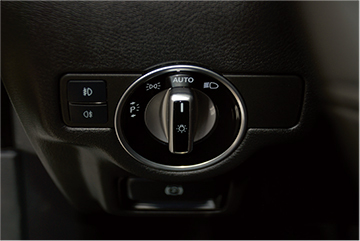
NOTE:
When the light switch is set to <AUTO> position, the low-beam headlights may not be switched ON automatically if there is fog, snow or other causes of poor visibility due to the weather conditions such as spray.
System Diagram
NOTE:
If the QX30 is equipped with Optional LED lighting, an extra LED control unit is fitted to the headlamp unit for control of the LED high and low beam.
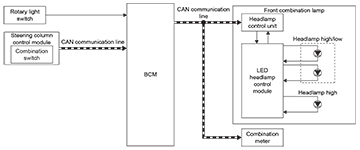
Daytime Running Lights
The daytime running lights operate when: The engine is running and the rotary light switch is in the <AUTO> position.

Manual Headlight Mode
When the ignition is switched ON and the rotary light switch is in the manual headlamp position, the sidelights and low beam headlights are switched ON even if the light sensor does not sense dark ambient light conditions. This is advantageous when there is fog or rain.
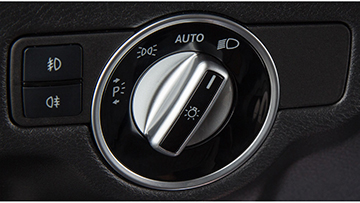
Manual Headlight Mode (continued)
- Turn the ignition to the ON position, or start the engine.
- Turn the rotary light switch to manual. The green indicator light in the combination meter lights up.
Sidelights (Parking Lights)
To turn ON just the sidelights, turn the rotary light switch to the side light position. The green side light indicator light in the combination meter lights up.
NOTE:
Sidelights (both sides), taillights, license plate lights, front parking lights, and combination meter turn ON. This position is similar to the parking light position on other Infiniti models.
If you hear a warning tone when you leave the vehicle, the sidelights may still be switched ON. Turn the light switch to <AUTO>. There is no OFF position.
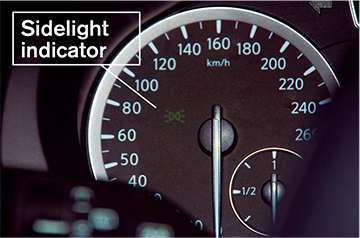
Parking Lights
To operate the parking lights (parking position on the rotary light switch), the ignition must be OFF.
There are two parking light positions:
![]() Left side: Only the left side parking lights are turned ON
Left side: Only the left side parking lights are turned ON
![]() Right side: Only the right side parking lights are turned ON.
Right side: Only the right side parking lights are turned ON.
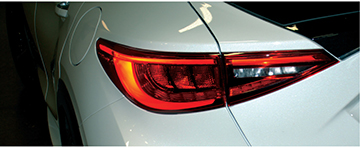
NOTE:
Left side rear parking lights ON.
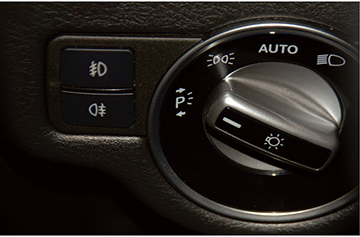
NOTE:
When using the P (parking positions on the rotary light switch), the front parking lights do not
turn ON.
High Beam Assist Operation (only available with LED headlights)
- When the high beam assist operation conditions are satisfied, the high beam assist indicator light in the combination meter (information display) turns ON and informs that the high beam assist is in operation.
High Beam Assist Condition
- Ignition switch ON
- Rotary light switch in the <AUTO> position
- Auto light systems has turned the headlights ON
- High beam selected with the combination switch
- The headlights are automatically switched between high and low beam based on signals from the optical sensors in the front camera unit.
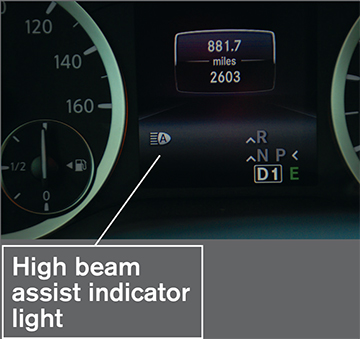
High Beam Assist System Diagram
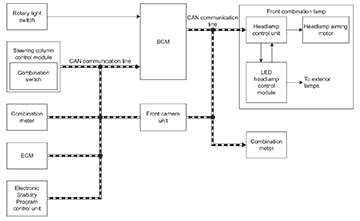
Fog Lamp Function
The front and rear fog lamps are controlled by buttons that are part of the rotary light switch. To turn the front or rear fog lamps ON, simply press the corresponding button. To turn them OFF, simply press the corresponding button once more.
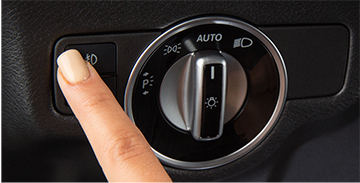
Front fog lamp operating condition:
- Ignition ON
- Rotary light switch in Auto or Manual position
- Front fog light switch pressed to ON
- Front fog light indicator light turns ON
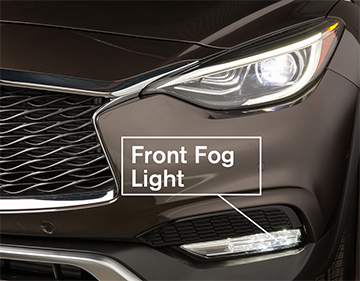
Rear fog light indicator
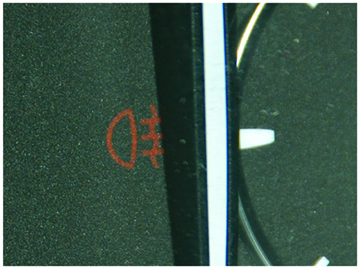
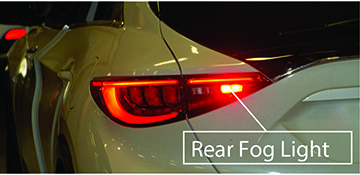
Rear fog lamp operating condition:
- Ignition ON
- Rotary light switch in Auto or Manual position
- Rear fog light switch pressed to ON
- Rear fog light indicator light turns ON
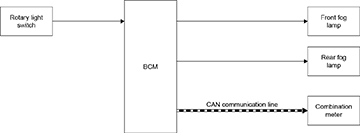
NOTE:
There is only one rear fog light; it’s on the left side as part of the left rear combination lamp.
Headlight Aiming Control
The QX30 has two types of headlamp aiming control (manual and auto). The LED headlamp-equipped models have automatic levelizers controlled automatically using front and rear height sensors. The Halogen headlamp equipped models have manual aiming control. These height sensors both detect vehicle front and rear height deviation with sensor level and then transmit the detected value to the headlamp control unit. The headlamp control unit detects the vehicle condition necessary for headlamp auto aiming control with the following signals: front height sensor signal, rear height sensor signal, engine status signal (received from ECM via CAN communication), low beam request signal (received from BCM via CAN communication), and the vehicle speed signal (received from Electronic Stability Program control unit via CAN communication). When these conditions are satisfied, the headlamp control unit then transmits a signal to the headlamp aiming motor and the swivel actuator to adjust the headlamp axis height.
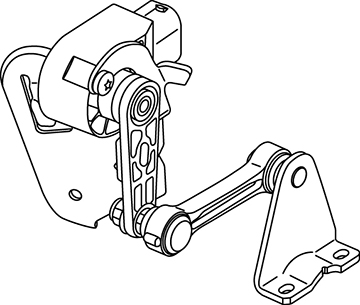
The front height sensor is installed in the front suspension member.
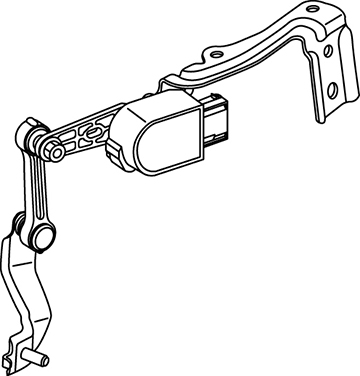
The rear height sensor is installed in the rear suspension member.
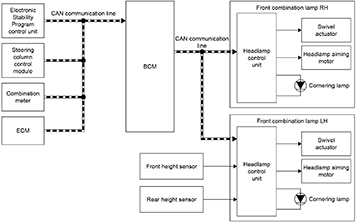
Was this article helpful? We value your opinion! Email us at TechTalk@nissan-usa.com.